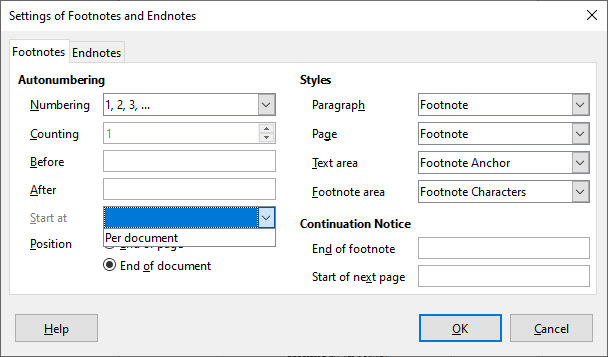First result: the “chapters” were written with LO 5.0.3.2.
I’m trying to discover the setting to reset footnote number. Perhaps, there was no parameter forcing in this release when you switch from notes at page bottom to at end of document.
There are also “many” formatting “rrors”, the most serious of which is using Default Paragraph Style for real text. This style is the ancestor of all others and everything you set there forces you to override in other styles when that setting conflict with your graphical charter.
EDIT
It was very difficult but I found something. I think a change between 5.0.3.2 and now (7.3.4.2 on my computer) is to be blamed for the difference. From experiment, when you configure your footnotes for “end of document”, numbering is reset to “per document”.
In the underlying XML, if I force the setting for “chapter”, Writer behaves as you were used to. Consequently, code for it is still there. I suppose this parameter forcing was introduced to remove a case of numbering ambiguity for the common case where notes at end have no chapter separator.
Bug report is tdf#150207
The temporary fix for you is not obvious and may be dangerous for your documents. I’ll give a procedure in an answer.
Analysis your “chapters” shows that your formatting is rather “elementary” and can greatly be improved.
- don’t use Default Paragraph Style for your text; Text Body is the standard style for this
- you never use character styles; instead you apply manual formatting for bold, italics and other variations
- don’t use empty paragraphs for vertical spacing; instead customise paragraph styles; since you don’t pay special attention to the style of these empty paragraphs, some of them are Heading n and end up in the TOC forcing you to manually edit the TOC to erase spurious entries
- you number your chapters manually instead of relying on
Tools>Chapter Numbering; in case you shuffle your chapters, you’ll have to renumber manually
If this is motivated by your need for unnumbered chapters, you can always have unnumbered headings by pressingBksponce at the very beginning of a heading. This removes the number. - don’t use manual page breaks for forcing page parity (starting a chapter on a right page); you’ll have to check this manually whenever you edit your book; instead play with page style properties and their automatic sequencing
- instead of inserting chapter “separator” manually among the end notes (which is not reliable in case of edits and isn’t possible with real endnotes), attach an unnumbered footnote to a chapter heading; the corresponding note will be inserted at the right location and you can style it with any style you like. With fields, you can also echo the chapter heading automatically, so that you don’t need to type it again (and when you modify it, the field updates)
- you’re not consistent in your end-of-sentence horizontal spacing
Sometimes you use two spaces after a full stop. This translates to a<text:s/>element in the XML (I don’t know what it does but I’d recommend using a single space and letting Writer do the job; double spaces disturbs its job)

